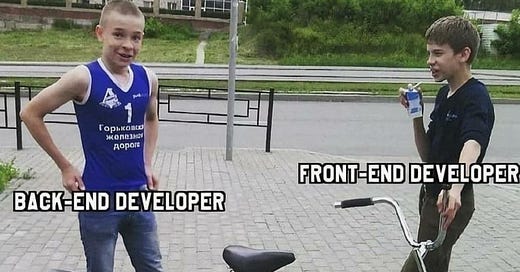The Back-End/Front-End Meme: A Fun Take, But What About Expandability?
Let’s Explore MCP and Agentic Frameworks
I recently came across the humorous meme (shown above) depicting the classic back-end and front-end developer dynamic as a clunky tandem bicycle. The back-end developer rides a functional yet basic frame (labeled "BACK-END"), while the front-end developer cruises on a flashy bike (labeled "FRONT-END"), connected by a makeshift "REST API." It’s a funny analogy, but it got me thinking about the limitations of this traditional setup—especially when it comes to expandability in modern software systems. Let’s compare this to advanced approaches like the Model Context Protocol (MCP) and agentic frameworks, and see how they address the gaps.
What the Meme Shows (and Misses)
The tandem bicycle captures a typical web development workflow:
Back-End Developer: Handles core functionality (databases, servers, logic).
Front-End Developer: Focuses on the user interface and experience.
REST API: Acts as the bridge for data exchange.
While this setup works for basic applications, it struggles with expandability:
Rigid Structure: REST APIs are static, making it hard to scale or adapt to new needs like real-time data or complex workflows.
Lack of Autonomy: Components can’t make independent decisions—they’re bound by predefined interactions.
No Context Awareness: The system doesn’t account for dynamic contexts (e.g., user behavior, system state), limiting its ability to grow.
Integration Challenges: Adding new features, like AI-driven insights, requires significant rework due to the lack of modularity.
Enter MCP and Agentic Frameworks
The Model Context Protocol (MCP) offers a smarter way forward. MCP enables dynamic, context-aware communication by maintaining a shared "context model" that all components can access and update. Think of it as a central hub that keeps everyone on the same page.
Agentic frameworks take this further by introducing autonomous agents—software entities that can reason, act, and collaborate independently. For example, one agent might handle data processing while another updates the UI, all coordinated via MCP.
Here’s how they differ from the meme’s approach:
Dynamic Communication: MCP replaces static APIs with a real-time context model, enabling seamless adaptability.
Autonomy: Agents can make decisions based on the context, adding intelligence to the system.
Expandability: New agents or features can be added easily, as the context model ensures interoperability.
Context Awareness: Components can respond to user needs, system states, or external events, making the system more responsive.
What’s Missing in the Traditional Approach?
The meme’s tandem bicycle lacks key elements for modern systems:
Modularity: Adding a new feature (or rider) means rebuilding the bike—similar to overhauling a REST API-based system.
Intelligence: The bike can’t “think” or adapt, unlike systems with autonomous agents.
Collaboration: The back-end and front-end are disconnected, lacking the dynamic collaboration needed for growth.
Context Management: There’s no mechanism to share or retain context, making real-time adjustments difficult.
How MCP Fills the Gap
MCP addresses these issues by enabling:
Dynamic Context Sharing: All components stay updated via the shared context model.
Modularity: New agents integrate seamlessly without disrupting the system.
Intelligent Decisions: Components can act based on the context, enabling features like personalization.
Better Collaboration: Agents work together efficiently, ensuring a cohesive system.
Why This Matters
For developers and teams building future-ready applications, moving beyond traditional setups is key. MCP and agentic frameworks offer the flexibility, intelligence, and modularity needed to scale and adapt in today’s fast-paced tech landscape. Let’s embrace these modern approaches to build systems that don’t just work—but thrive.
What are your thoughts on modern software architectures? Have you explored MCP or agentic frameworks? Share in comments.





